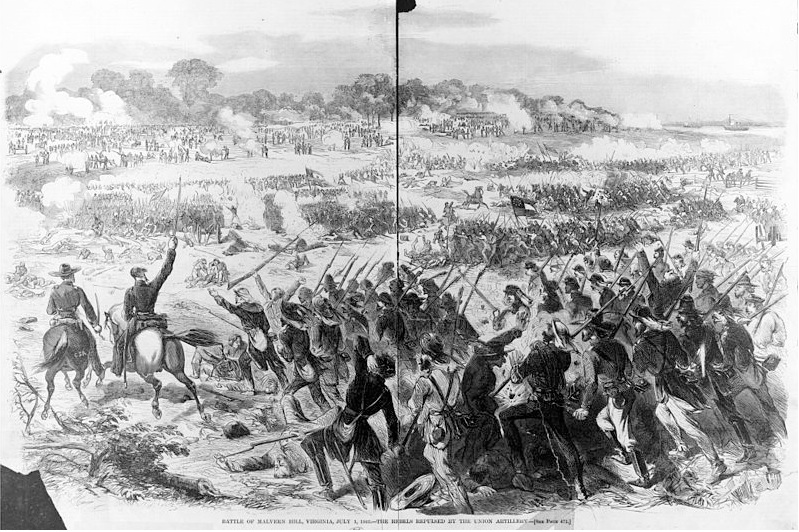
The Civil War in Virginia, for those interested in political and social history, can be introduced with four books from the battlefield, the naval war and amphibious operations, motives of the fighting men, and Lee’s Army of Northern Virginia.
Battle Cry of Freedom is perhaps the best single volume of the Civil War that places military history in political and social context. Virginia saw naval developments both at sea and by river, with ironclads and by sail described in By Sea and By River: The Naval History of the Civil War.
The motives and the spirit of 19th century American armies are explored in For Cause and Comrades. Lee is evaluated as a field commander, a military strategist, and an historical figure in Lee and His Army in Confederate History.
Battle Cry of Freedom

Battle Cry of Freedom (1998, 2003) is written by James McPherson, who won a Pulitzer Prize for this book. The author captures the spirit of the times, beginning with the tides of sectional feeling in state capitol and county courthouse for the first third of the book.
He then develops a narrative of military and political events, including social and industrial aspects of the Civil War. McPherson features descriptions of major campaigns, with treatment of both strategy and tactics on both sides. Though there are numerous contingent moments where victory or defeat hung in the balance, the North gradually developed both military and industrial superiority.
A detailed bibliography and notes contributes to the usefulness of this volume as an introduction to the Civil War. Buy “Battle Cry of Freedom” at Amazon.com here.
By Sea and By River

By Sea and By River: The Naval History of the Civil War (1962, 1989) by Bern Anderson builds an account of the strategic civil war plans, battles and campaign attainments, and naval contributions to the final outcome, bringing to light the importance of the relentless Union blockade and the Confederacy’s inability to break it.
The emphasis on the strategic also includes context for individual engagements and developments in tactics and armaments. Anderson, a former assistant to famed WWII naval historian Samuel Eliot Morison, also touches on navy department politics, comparative abilities of naval commanders and the development of joint naval-military amphibious operations all along the Confederacy’s coasts. Buy “By Sea and By River” at Amazon.com here.
For Cause and Comrades

For Cause and Comrades: Why Men Fought in the Civil War (2003) by Gary W. Gallagher describes the Civil War fighting men’s motives for joining, fighting and persisting in the four year’s long conflict. He focuses on a thousand letters of the volunteers from 1861 and 1862, not the later conscripts, nor deserters, and Gallagher does not take under consideration what he estimates to be the half who were shirkers. Among his subjects who did most of the fighting and much of the dying, duty to save their country seemed uppermost among Northerners along with honor, honor seemed stronger among Southerners along with duty.
Patriotism was apparent on both sides, supported by 19th century evangelical religion less common in the 20th century. Men fought for fear of letting down comrades who were also neighbors in the hometown regiments, or disgracing the families left behind, or dishonoring themselves in a moment of cowardice.
Both sides expressed sentimental devotion to flag, Constitution, liberty and the American Revolution; Confederates also stressed defense of their hearth and home. Both sides held an ideology for freedom, which McPherson emphasizes in the Civil War fighting man’s motivation. Their respective “cause” was a guiding star to which they affixed devotion of duty and honor, with emotional aspects not seen in the letters of modern soldiers. Buy “For Cause and Comrades” at Amazon.com here.
Lee and His Army

Lee and His Army in Confederate History (1999, 2003) by Gary W. Gallagher is a collection of eight essays looking at both traditional and revisionist scholarship with an eye to understanding the Confederate experience with General Robert E. Lee and his Army of Northern Virginia, in combat leadership, with his strategic thinking and the generalship of his lieutenants, and as an historical figure of the “Lost Cause”. Gallagher is at pains to consider a variety of viewpoints, using evidence from the Confederates of the time to counter both those who canonize Lee and those who dismiss him.
Lee’s early victories led to his great confidence in the army, and the army’s great confidence in him, however frustrating their defensive character might have been to him personally as a general. Even the reverse at Gettysburg was seen as minor in the Confederacy at the time, and home front morale that hinged on Lee’s Army remained high into the 1864 campaign. Lee understood mass armies in the 19th century democratic republic, modern national war as opposed to local conflict, and the implications of military operations on civilian morale.
Lee’s military abilities on the battlefield contributed to the duration of the Civil War and they crucially sustained the will to continue the fight on the Confederate home front, even as the rebel nation became surrounded and two-thirds of its initial territory became Union occupied by 1864.
Gallagher’s critique finds the prominent, dominant Lee in the story of the Confederacy akin to the military accounts of Jubal Early and Douglas Southall Freeman. And while he rejects dismissive analysis by revisionist historians, Gallagher also cautions that Lost Cause distortions of slavery and other matters cannot be swallowed whole. Buy “Lee and His Army” at Amazon.com here.
For other book reviews of Virginia histories, see the Book Club here. For The Virginia Historian’s 12-steps to your personal library on Virginia history, click here.

